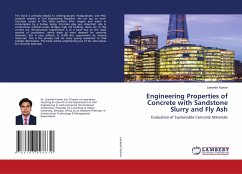
Waste Foundry Sand Concrete - An Experimental Study
Utilization of Waste Foundry Sand in Concrete by incorporating Polypropylene fibre and Fly Ash using Taguchi Method
Versandkostenfrei!
Versandfertig in 1-2 Wochen
26,99 €
inkl. MwSt.

PAYBACK Punkte
13 °P sammeln!
With an increase in quantities of industrial bi-products, solid waste management is of special significance. Approximately two million tons of Waste Foundry Sand (WFS) is produced yearly in India. Improper disposal of waste foundry sand imposes environmental effects such as inhibition of soil microbial activity and groundwater toxication. Using WFS as a building material can effectively reduce the environmental effects and disposal concerns. Strength requirements and cost reduction are achieved by partially replacing cement with fly ash. Polypropylene fibre increases the ductility of the concr...
With an increase in quantities of industrial bi-products, solid waste management is of special significance. Approximately two million tons of Waste Foundry Sand (WFS) is produced yearly in India. Improper disposal of waste foundry sand imposes environmental effects such as inhibition of soil microbial activity and groundwater toxication. Using WFS as a building material can effectively reduce the environmental effects and disposal concerns. Strength requirements and cost reduction are achieved by partially replacing cement with fly ash. Polypropylene fibre increases the ductility of the concrete. In this paper, work behavior of M25 concrete was studied by replacing natural sand with WFS (10%, 20% and 30%) by weight, cement with fly ash(20%, 25% and 30%) by weight and polypropylene fibre was added (0.5%, 1% and 1.5%) by weight of cement. The mix proportion parameters of the concrete were analyzed using the Taguchi method for the optimal design of experiments. The mixtures were tested both in the fresh and hardened state, and the optimized mixture was identified based on the test results using Signal to Noise ratio.












